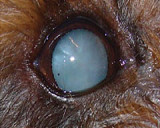Most ocular disease whether it be deep disease like uveitis, or superficial disease like allergic conjunctivitis will manifest clinical signs involving the conjunctiva.
“Seeing” how it reacts is vital to understanding how to treat conjunctivitis.
Learn the Anatomy
Learn the Anatomy
The conjunctiva is connective tissue divided into bulbar (globe) , palpebral (eyelid) and fornix regions. It separates the periorbital tissue from the Tenon’s capsule. Palpebral conjunctiva is NOT freely moveable, whereas the bulbar conjunctiva is. The superficial layer plays host to adenoid follicles and glandular structures whilst the deeper layer contains branches of the ophthalmic and maxillary nerves and larger blood vessels.
Normal flora and normal cytology.
70-90% of dogs can have bacteria cultured. Staphlococcal, Bacillus and Corynebacteria predominate. 8% gram negative bacteria, anaerobes rarely isolated. Normal cytology sheets of non-keratinised squamous epithelium, with lots of cytoplasm.
Understand its function
Understand its function
1.Movement of the eyelids and the globe
2.Contributes to the tear film.
3.Prevents drying out of the cornea
4.Immune response
5.Corneal healing
6.Provide a barrier against microorganisms and foreign bodies.
Clinical signs
See the clinical signs (examine the photos carefully)
1. Hyperaemia - redness
2. Chemosis (swelling)
3. Chronic inflammation - desiccation, multi-nucleate giant cells, keratinised epithelial cells
4. Ocular discharge - watery, mucoid, purulent or a combination of these.
Superficial versus Deep Hyperaemia
Differentiating Superficial versus Deep Hyperaemia (examine the photos carefully)
1. Superficial conjunctival vessels are smaller, branched, mobile and blanch with topical epinephrine.
2. Deep conjunctival vessels are shorter, straighter and do not blanch with topical epinephrine.
Associated diseases
Diseases associated with canine conjunctivitis
1. Superficial causes:
- Allergic conjunctivitis
- Topical irritant - medications to toxins
- Foreign body
- Corneal ulceration
- Infectious - bacterial, viral, parasitic,mycotic, rickettsial
- Tumours of the conjunctiva
- Trauma
2. Deep causes:
- Glaucoma
- Uveitis
- Episcleritis
- Scleritis
- Hyphaema
- Trauma
Treatment
Managing Treatment
MUST IDENTIFY THE CAUSE For most superficial conjunctivitis - topical steroids such as prednisolone - Prednefrin forte ® or dexamethasone - Maxidex ® are beneficial. The frequency depends upon the severity of the conjunctivitis.
TOPICAL STEROIDS ARE CONTRAINDICATED WITH CORNEAL ULCERATION
In deep conjunctivitis topical and systemic anti-inflammatory drugs are required.









